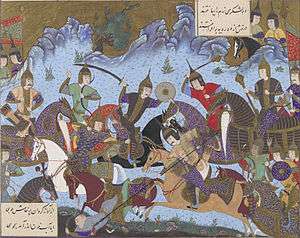Khushnavaz
| Khushnavaz | |
|---|---|
| Hephthalite king | |
| Reign | 450s - 480s |
| Predecessor | Unknown |
| Successor | Unknown |
| Died | 480s (?) |
Khushnavaz (also spelled Khush-Newaz; Sogdian: Əxšāwan’ār; Middle Persian: Xašnawāz), also known as Akhshunwar, was a Hephthalite king who ruled in Tokharistan. At the zenith of his power, he ruled an empire stretching from Gorgan in the west, to Balkh in the east.
Etymology
The word "Khushnavaz" is of Sogdian origin and means "king"—it was used both as a title and name.
Biography
The usurpation of Hormizd
Khushnavaz is first mentioned in 457, when the Sasanian king Yazdegerd II died. After his death, his youngest son Hormizd III seized the throne in the absence of his elder brother Peroz I who was serving as governor of the distant Sistan province. Peroz I was thus forced to flee to Hephthalite territory and seek aid from Khushnavaz, who gladly accepted to help him. In 459, they defeated and captured Hormizd—Peroz thereafter ascended the Sasanian throne, and ceded Taliqan to Khushnavaz.[1]
War with the Sasanians
However, in the early 460s, a war between the Khushnavaz and Peroz erupted.a[›] During the start of the war, Peroz did not have enough manpower to fight Khushnavaz, and therefore asked the Byzantine Empire for financial aid, which was declined.[1] Peroz then sought to make peace with Khushnavaz, and offered him his sister in marriage. However, Peroz tried to trick Khushnavaz by sending a woman of low status instead.
After some time, Khushnavaz found about Peroz's false promise, and then in return tried to trick him by requesting him to send military experts to strengthen his army. However, when a group of 300 Sasanian military experts arrived to the court of Khushnavaz at Balaam (either the same city as Balkh or a city in Sogdia), they were either killed or disfigured and sent back to Iran, with the information that Khushnavaz did this due to Peroz's false promise.[1] What happened after remains obscure, it is only known that in 467, Peroz managed to capture Balaam.[1] However, Khushnavaz managed to quickly recapture Balkh. Peroz, weary of war, made peace once again with Khushnavaz.
In 469, war once again erupted, which resulted in Peroz suffering a heavy defeat in a battle near Gorgan, and also being captured by Khushnavaz's forces. He was, however, released after he paid ransom,[2] which the Byzantines aided him in by lending him some money.[3][2]
In ca. 471, Peroz, provoked by an insult heaped upon him by Khushnavaz, Peroz, along with his vassal Vakhtang I,[4][5][6] invaded Khushnavaz's territories, forcing him to retreat. But when Peroz pursued the Khushnavaz and his men to the hills, he suffered a crushing defeat, was captured and forced to surrender his daughter, his son Kavadh I, and the chief priest (mowbed) of the empire to Khushnavaz as a hostages, until ransom was paid.[7]
In ca. 484, Peroz gathered an army of 50,000-100,000 men and invaded the Khushnavaz's domains in order to avenge the insult heaped upon him during the first campaign. He set up his position somewhere in Khorasan and rejected the terms of peace offered by Khushnavaz. However, when a showdown with the Sasanians seemed imminent, Khushnavaz sent a small body of troops in advance in order to trick Peroz into an ambuscade at Herat. The plan was successful, and the Sasanians were defeated with great slaughter, Peroz being one of the victims. Khushnavaz, however, treated the body of his erstwhile friend with dignity and dispatched it to Iran to be buried with full honors.
Fatal confrontation with Sukhra

Soon afterwards, Khushnavaz invaded and plundered the eastern part of the Sasanian Empire. However, he was shortly defeated by the powerful Sasanian aristocrat Sukhra, who made Balash the new king of the Sasanian Empire. According to Ferdowsi, some time before 488 Khushnavaz had been succeeded by another king, whose name is unknown.
References
- 1 2 3 4 Zeimal 1996, p. 130.
- 1 2 Litvinsky 1996, p. 142.
- ↑ Daryaee 2008, p. 25.
- ↑ Toumanoff, Cyril (1963). Studies in Christian Caucasian History, pp. 368–9. Georgetown University Press.
- ↑ Thomson, Robert W. (1996), Rewriting Caucasian History, pp. 153–251. Oxford University Press, ISBN 0-19-826373-2
- ↑ (in Russian) М. Лордкипанидзе, Д. Мусхелишвили (Ред., 1988), Очерки истории Грузии. Т.2: Грузия в IV-X веках. АН ГССР, Ин-т ист., археол. и этнографии – Тб. : Мецниереба: Тип. АН ГССР.
- ↑ The Cambridge history of Iran: The Seleucid, Parthian and Sasanian Periods, Vol.1, Ed. Harold Bailey, (Cambridge University Press, 1983), 148.
Sources
- Pourshariati, Parvaneh (2008). Decline and Fall of the Sasanian Empire: The Sasanian-Parthian Confederacy and the Arab Conquest of Iran. London and New York: I.B. Tauris. ISBN 978-1-84511-645-3.
- Brunner, C. J. (1984). "AḴŠONVĀR". Encyclopaedia Iranica, Vol. 1, Fasc. 7. pp. 729–730.
- Zeimal, E. V. (1996). "The Kidarite kingdom in Central Asia". History of Civilizations of Central Asia, Volume III: The Crossroads of Civilizations: A.D. 250 to 750. Paris: UNESCO. pp. 119–135. ISBN 92-3-103211-9.
_of_Firdawsi_LACMA_M.73.5.23.jpg)